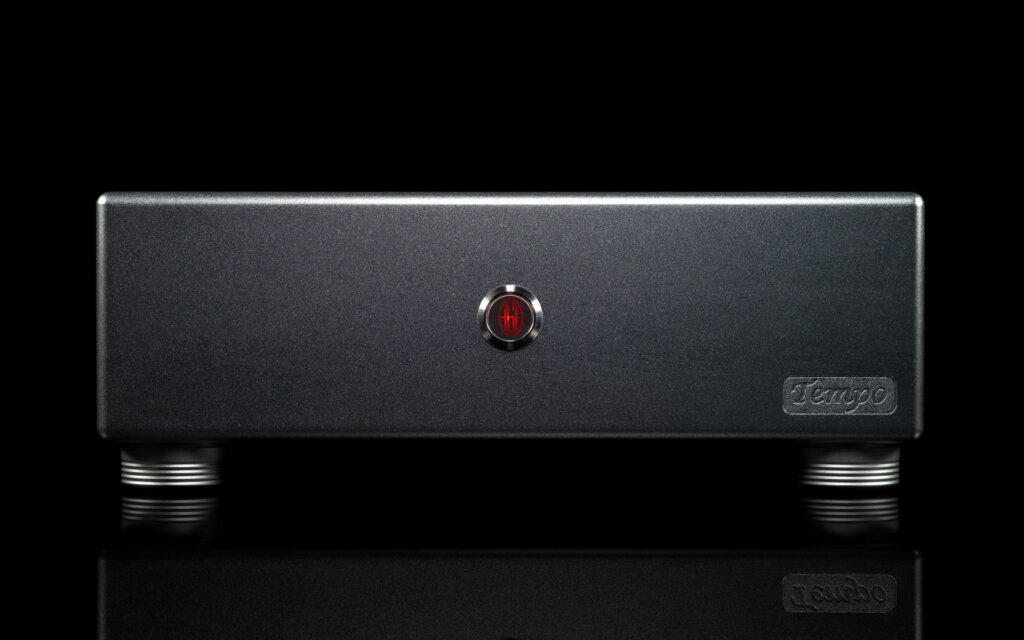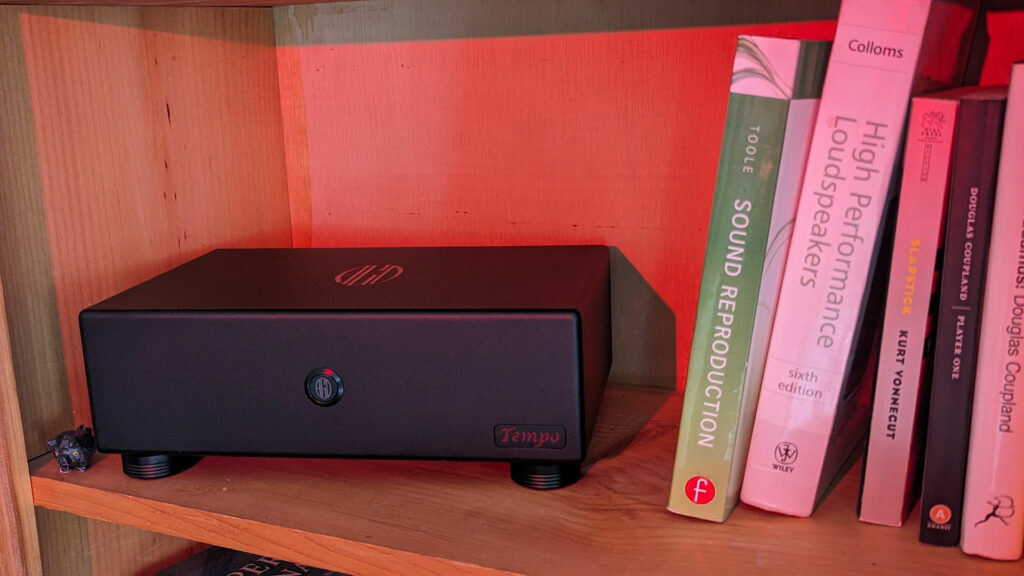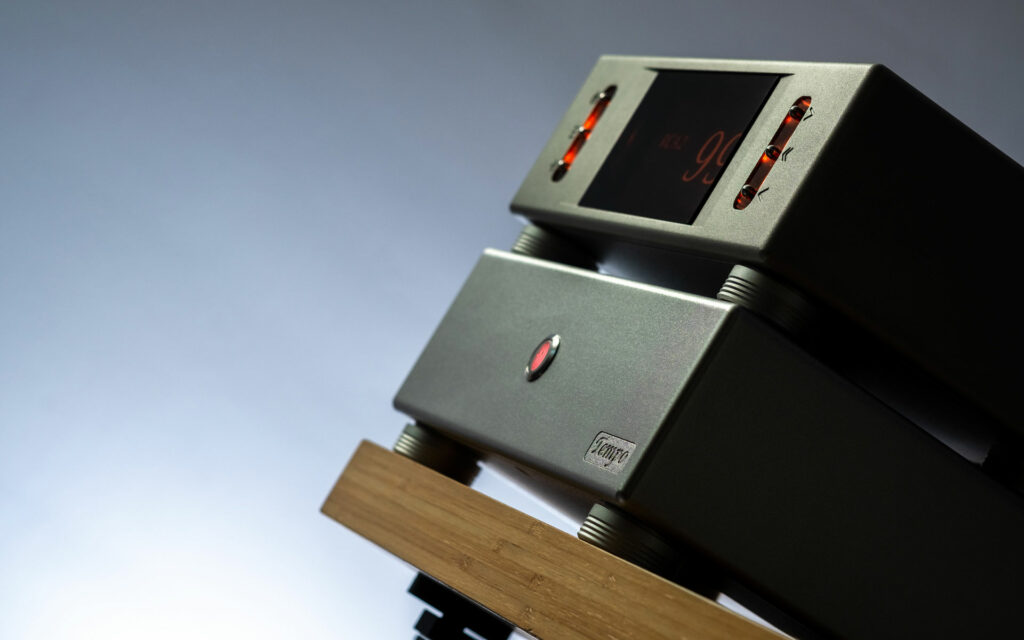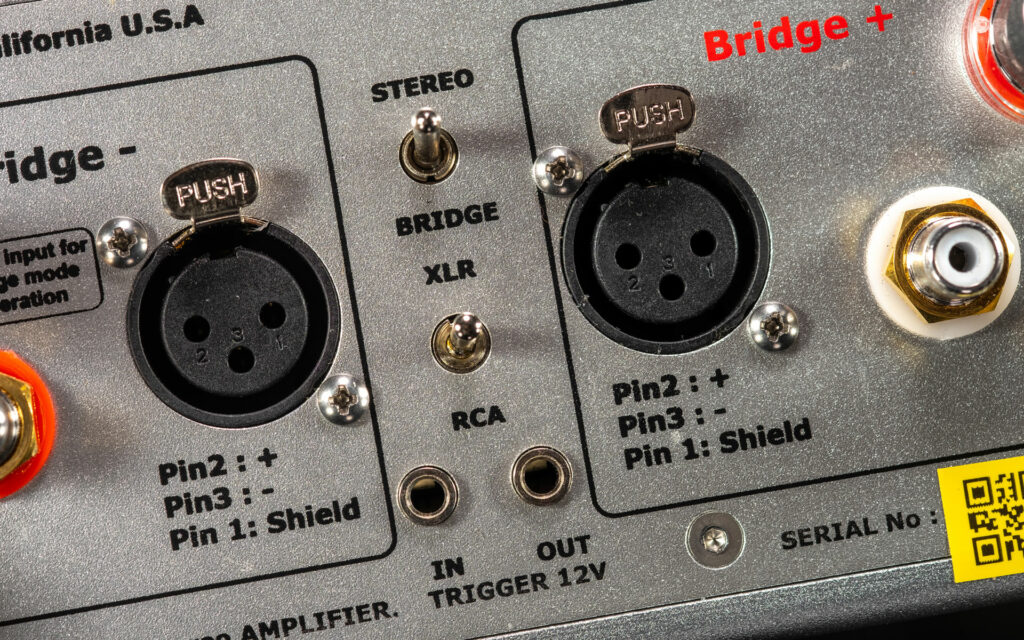Have you heard of Gallium Nitride (GaN) audiophile amplifier technology? If not, let me let you in on a little audiophile secret: unlike loudspeakers, which haven’t benefited from a major technological breakthrough in generations, GaN amplifiers represent a total rethinking of how an audiophile amp works, as well as how it fits into a modern stereo system. GaN technology technically relies on Class-D topology, but it operates at double the switching frequency of traditional Class-D amps. GaN designs tend to be amazingly efficient, with AGD products setting the pace on this matter for the entire audiophile industry. GaN amps also create little to no heat. GaN designs don’t tend to come in the form of large amps, physically, and as such need less metal to build and thankfully cost less to ship. They are powerful amps that are highly stable, even into tougher, sub-four-Ohm loads. But that’s not the real hook on this new technology. The best part is that GaN amps, at their best, can provide that linear sound that audiophiles love from single-ended triode (SET) or highly inefficient Class-A power amps.

AGD Productions isn’t a brand-new audiophile amp or electronics company, but it recently had its coming-out party and people are really starting to notice – specifically with the AGD Productions Tempo Di Gan (aka: Tempo) Gallium Nitride, semiconductor-based amplifier priced at $5,500.
This isn’t an affordable amp, per se, but when looking for comparisons, you need to seek out products from the absolute best audiophile electronics companies and with retail price tags that top out at many, many times more money than the AGD Tempo. If this all sounds too good to be true, I feel you. Stick with me, as this amp is something that you need to know more about.

What Makes the AGD Productions Tempo Amplifier So Special?
- The ADG Productions Tempo GaN Amplifier delivers 100 watts per channel into eight Ohms, doubling to 200 watts at 4 Ohms. While traditional Class-D amps might output more stated power, this is one stable and linear amp that really does sound like a Class-A or SET tube amp. It measures wonderfully well compared to more traditional designs such as Class-A or even other Class-D designs
- The AGD Productions Tempo can handle the ever-changing, complex impedance loads presented by loudspeakers with ease which means far more options for audiophiles when selecting loudspeakers. If there is a loudspeaker you love, the AGD Tempo will almost certainly drive it. It is just that stable and powerful even with a somewhat conservative 100-watt rating into 8 Ohms.
- The Tempo uses ultra-high-frequency switching thanks to AGDs proprietary technology. It switches at 800 kHz, whereas traditional Class-D (non GaN, non-AGD amps) switch at 400 kHz. Faster switching often means higher signal accuracy, and is a key to fulfilling AGD Productions’ claim of single ended triode or Class-A sound quality, but with high power output and low power drawn from the wall. The technology in the AGD Tempo goes beyond a few new transistors and a fast clock.
- All of the elements of the AGD Tempo, including special circuit board materials and signal paths, measure in the millimeters (instead of feet like many more traditional, old school designed amplifiers). The difference is like comparing a modern Apple MacBook Pro to an old PC from 1982. There is a gigantic difference in the overall efficiency of the design.
- The power supply used in the Tempo is as robust as designer Alberto Guerra could find. Guerra states that, no matter what the amplifier design methodology, 50 percent of the performance of any amp comes from having an excellent power supply. The one that AGD uses is one of the biggest reasons why this GaN amp sounds like an uber-audiophile amp when other Class-D amps tend to sound a little cold and harsh. The power supply is everything and AGD didn’t skimp in the Tempo.
- Want even more power, or a path for a future upgrade? The Tempo can be run in bridged mode to deliver 400 watts into one channel. Add in a second Tempo and now you have massively powerful but diminutive and cool-running set of amplifiers that weighs less than the power transformer in my trusty, but now departed, Parasound A21+ power amp (read the review).
- Reported distortion, power bandwidth, and dynamic range are all on-par with top-tier audiophile amplifiers. I come from the school that says that it is better to underestimate and overdeliver, which is why I find the already impressive specification of <0.01 percent THD+N (10W/1KHz) a little curious. Especially since the Tempo also touts a power bandwidth of 5 Hz-80 kHz and signal-to-noise of >120dB. The level of which the most subtle detail exists approaches my reference Bricasti M30 monoblock amplifiers, which are $30,000 per pair retail and about as good a power amp as you can dream of at any price.
- The AGD Tempo comes with beautiful industrial design and tremendous attention to detail when compared to any audiophile amp in the market today. The cutting-edge amplifier has a luxurious feel and I simply love the backlit power button that touts the AGD logo in a deep red, which is reminiscent of the old fashion bulb-lit amplifier design details from the past. Even the carbon fiber embellishments on the gold-plated copper binding posts are sexy but not flashy.
- The amplifier arrived packed in a Pelican case, with a top-notch power cord, white gloves, cleaning cloth, and a sealed envelope that contains the manual with an invitation to enjoy. What does this have to do with the sound? Except for perhaps a high-quality power cord, which all manufacturers should supply with audiophile gear, these details do little to enhance the actual performance of the AGD Tempo but they do create a wonderful sense of pride of ownership.
- This GaN amplifier is amazingly energy efficient unlike the best audiophile amps that it aims to better. There is no greater summary as to how far amplifier technology has come than this… 94 percent of the energy used by the AGD Tempo is turned into sound. The best you get with Class-A is about 50 percent and 78 percent at most with more traditional Class A/B designs. This means the AGD Tempo uses less power to do the same work as the monolithic giant amplifiers that often double as space heaters. The AGD Tempo not only uses less power from the wall but it is lighter and easier and less costly to ship. Traditionalist might not be able to understand how a smaller amp can have more power but this isn’t a traditional audiophile magazine.
Why Should You Care About the AGD Productions Tempo Amplifier?
The AGD Tempo GaN amplifier, at $5,500, represents a totally game-changing event in the audiophile world. Will every audiophile embrace the value proposition of a smaller amp that uses way less power and is built to be more environmentally sensitive, yet can smoke a big pair of heavy and wasteful monoblock amps designed to be parked on the floor next to your favorite speakers? Nope. But the enlightened audiophiles who want performance that rivals (or surpasses) the most exotic audiophile amplifiers from Switzerland, Japan, or the most lauded designs from right here in the USA, might be shocked at just how much power, control, and headroom can be had from this relatively affordable audiophile amplifier. The AGD Tempo can basically drive damn-near any speaker that I could find with ease while using very little power from the wall, creating barely any heat, and with stats that rival the best, most expensive, most power hungry Class-A power amps that cost many, many times more.

Some Things You Might Not Like About the AGD Productions Tempo Amplifier.
- If you need truly outrageous amounts of power to drive your speakers, you might need a second AGD Tempo amp to run in a bridged configuration or better for the overall sound quality as Alberto explained to me, in bi-amp mode (driving the low and mid/high section of one speaker using one Tempo in normal STEREO mode). The doubles one’s expense but is still far, far less money than other, less-efficient amplifier designs. To be clear, the AGD Tempo powered every speaker in my collection with ease and ample headroom. One Tempo is likely perfectly fine for nearly every demanding audiophile out there. It is nice to know that there is a path to go to true extremes that isn’t too costly or difficult to implement.
- AGD Productions is relatively new player in the audiophile world. It is sold mostly (but not exclusively) direct and offers a mind-bendingly positive value proposition. For some traditionalist, this will be like giving up their gas-powered cars for an electric. Even with sub-three-second 0-to-60 times, electric cars are just different. So is GaN. It offers higher performance and more efficiency than other amps in the high-end audiophile market today. I guess I can understand if some people think that this deal is just too good to be true, but boy are they missing out.
- The slight sonic signature of the Tempo may not be for everyone. SET/Class-A amplification is beloved by audiophiles because of its linearity and ability to produce an unparalleled accuracy in the critical midrange frequencies. This signature often comes across as laid-back and less visceral than some enjoy. This returns to the characteristic conversation where sonic signatures are not really a flaw, but an inherent design decision.
- Not every audiophile will be up for this level of technological change. I can pontificate here on Future Audiophile until I am blue in the face about the advancements in technology the AGD Tempo represents; however, some people still want an amp that is big and beefy. That stereotype might be hard for a lot of traditionalists to get over. Others will not be able to get over the cognitive dissonance created when they hear the AGD Tempo and must accept it is actually a Class-D amplifier.
- If we lost the fancy packing, would it save me $500? I appreciate the experience AGD Productions is creating with the fancy packaging. Nothing will pass a gorilla luggage test better than a Pelican case. The solid click of the latches and the first sight of the equipment is really something special. But I receive most of my high-end equipment in a cardboard box, and it arrives safely.
Listening To the AGD Productions Tempo Amplifier…
Melanie Martinez’s music blurs the lines between industrial rock/metal, modern pop, and electronic music. This odd mixing of genres is especially present in her most recent album PORTALS. Her voice, whose sound seems suspended in early teenage years, is driven by a musically mature, 28-year-old mind. “Milk of the Siren” is a song about feminine strength that contains a bouquet of complex instrumentation. However, this track’s well-recorded nature, as reproduced on the Tempo, flings the music into the room, completely engulfing the listener in every dimension, including from behind. The precision and seamlessness of the AGD Tempo, along with its ability to reproduce the theatrical dynamics present in this track, was hair-raising. The Tempo hit all these key performance points while keeping Melanie Martinez’s voice preserved with texture, dynamic inflection, and all the breathy mystery and intoxication a siren’s voice would possess.
I would be doing the AGD Tempo an injustice if I did not include an audiophile classic track. Cassandra Wilson’s New Moon Daughter album is available through Qobuz in 24-bit/192KHz resolution. Her rendition of Neil Young’s “Harvest Moon” is simply to die for with the AGD Productions Tempo amp in my reference system. From the moment the atmosphere is created by tree-frogs chirping, bowed-bass gently sliding into the soundstage, and muted-harmonics on the stringed instruments, the Tempo showed why it clearly can claim it possess the qualities of a Class-A or SET amplifier. Not only were these instruments clear, honest, and seamless sounding in all aspects true to their nature, each artist’s individual messages came through creating a breathtaking soundscape. Then there was Cassandra Wilson’s voice. Dark, deep, wistful, and full of texture. I was absolutely transported by the Tempo on this track to a magical, late summer/early fall evening by the lake at the end of the fields.
Does the AGD Productions Tempo Have Any Resale Value?
Since the Tempo amp offers bleeding-edge technology via a company that is finally gaining a serious foothold in the audiophile space, most people that would buy an AGD amp now know what they are getting and wouldn’t likely sell it. Could other, better-distributed and -represented audiophile brands get a slightly higher percentage of the retail price in the used market? Perhaps. Will you (or anyone else) likely sell an AGD Tempo anytime soon? That seems like the more relevant question.

Who Is the Competition for the AGD Productions Tempo Amplifier?
The $5,000 Amped America AMP 2400 amplifier (read the review) is the closest match for the AGD Productions Tempo GaN amp. This was a fun review since I had both in-house at the same time and went back and forth between them a dozen times. Unlike the ultra-refined Class-A/SET nature of the Tempo’s GaN circuitry, the AMP 2400 is an exercise in perfecting the more traditional Class-D topology based around the same chipset Jeff Rowland Designs uses in its $30,000 Class-D amplifier. The Amped AMP 2400 touts a massive 800 watts per channel into four Ohms, which is four times as much power as the AGD Tempo.
Even at normal listening levels, the huge power of the AMP 2400 is apparent and beats the Tempo in terms of headroom. The AMPED 2400 is still Class-D, though extremely good Class-D, and exhibits some of the topology’s inherent characteristics discussed earlier. This is not a bad thing, just a different thing, and if looking for serious high-fidelity power that is dead-center neutral on the tonality scale, the AMP2400 must be a very, very serious consideration.
Peachtree Audio makes the GaN400 for $2,499. This little beast will deliver 400 watts into 4 or 8 ohms and has low published distortion. The AGD Tempo reports to have better overall specifications, but for one-half the price, it is possible to explore the benefits of GaN technology with the GaN400. Most times, what is left unsaid in a specification sheet are areas where a manufacturer may not want to muddy the waters on their own product. Not because there are dead bodies to hide, but it is all too easy for most audiophiles to get too hung up on numbers that are not fully understood and can open to a degree of interpretation.
One area I believe the Peachtree GaN400 may fall short is in the switching frequency of the amplifier section. The high switching frequency of the AGD Tempo is what makes its top-tier performance possible. This is not a buyer-beware statement against the Peachtree GaN400. What I can see forming in the distance is GaN’s first hurdle. Without utilizing all its capabilities, GaN is just another way of designing good Class-D products, instead of products that are truly next-level. It will be confusing to audiophiles since less-than-optimized GaN technology may fall short on its first impression when compared to great Class-D like the Amped America AMP2400.

Final Thoughts on the AGD Productions Tempo Amplifier…
At $5,500, the Tempo di GaN by AGD Productions is a bleeding-edge example of the future of audiophile amplification. Using the latest technologies available and advanced circuit design, the company has flipped the table in the face of generations-old perfected technologies such as Class-A and SET amplification. The Tempo has stolen what makes these amplifiers the pinnacle of fidelity and improved upon their highly-desired traits. Sure, the Tempo does not have the outright drive of larger Class-D amplifiers at the same price, but isn’t that what AGD Production’s larger offerings are about? Besides, the Tempo proves not all watts, even in the Class-D world, are created equally, and in the scope of my regular listening I never found the Tempo to lack the drive I desired.
My first experience with AGD Productions back in 2020 was with its Audion amplifier, which was certainly top-tier, and sharing much of the same amplifier technology like what is found inside of the Tempo GaN amp. The Tempo shows how quickly the engineering brilliance of AGD can change the audiophile amp game, so much so I have made the decision to own the Tempo, which means it’s dethroning my Parasound Halo A21+, which held fast in my system for almost 10 years (I owned the A21 previously). The audiophile amplifier game has changed and so have I, and I am not looking back, as the AGD Tempo is simply superior to what we thought were some of the best amps at this aspirational price range.




Excellent review! I wonder if you could further characterize ANY character or flavor of this Gan-FET design? Superb linearity without spectral tilt are a given, I suspect. Does the possibly flatter mid-to-low treble FR simply mean a delta from the frequent anomolies of SET (esp high output impedance) designs?
In my experience with GanFET modules flat frequcncy response AND timbral density with and overtone realism rival the best Class A designs. (My reference is my Steinway B sitting between my speakers.)
Thanks again for fine writing and analysis.
I had the amp in my system for about two weeks before sending it back.
The no-heat element is very alluring as the amp that I chose over the AGD, the Pass Labs XA25, creates a LOT of heat and in my rack – that can be an issue.
The sound of the amp is very neutral. It sounded a lot like the Classe Delta Stereo Amp (review pending from me in the coming weeks) or the Pass Labs. Very accurate but not flavored per se.
The odd size of the amp is hard to work with but begs some interesting questions as to if we really need big, heavy audiophile amps from the past to get great sound.
We’ve got the Peachtree GaN in with Michael Zisserson. We also have the much less expensive Orchard Audio GaN reviewed and waiting to run. Steven Stone LOVED that $2,995 amp.
Another contender in this competitive, new-world amp space is the AMPED 2400 which uses the Pascal chip versus Gallium Nitride semiconductors. It has more powerful and is VERY CLOSE in terms of performance – so says Michael Zisserson who reviewed both the AGD and the AMPED 2400.
Hi Ernie,
To add to Jerry’s comments. I believe that if we were to remove the output filtering of the amplified signal, we would see an amplified signal with nothing significant added to it. Einstein stated: Not everything meaningful is measurable, and not everything measurable is meaningful.
This is not a lazy cop-out, rather understanding our senses have limits, and there is a point where we can measure, but what is created is so technically good is it adding anything meaningful, or can it even be precieved?
Back to the amplified signal: I think it is ultimately up to the manufacturer what the end result of a GaN product sounds like by carefully manipulating the output filtering, not unlike like a DAC.
This may be a problem for those who actually sit and listen to things like warble tones and pink noise, but at the end of the day it means very little in terms of music.
There are also an extreme amount of variables that go behind what the GaN amplifier section is doing, and dozens of places more fine, cumulative errors can occur before it reaches your ears.
This is my really long answer to: I think AGD has engineered a great formula to get their Class D GaN to sound like a SET amp, but with bravado! Others may proceed differently, but for me, when I listen, it provides the expirence I look for which is why I decided to go with the Tempo as part of my line up.
Hope this helps, and thanks for the inspiring thoughts!
Hi Michael. I revisited your review, and now am reminded of the possibilities of altering maybe soundstage characteristics, rather than outright tonality, by varying GaN-FET designs’ output filters. I decided to use premium Mundorf SGO (Silver/Gold/Oil) caps in my ArgentPur design, as there’s what I believe is an appreciated positive delta by pushing the soundstage back a bit, but extending WAY past the front wall, compared to the otherwise-excellent OEM Panasonic film caps. Despite the expense I decided to use these filter caps both in my Monos and the upcoming stereo DUO design. Thanks again for your insight. ErnieM